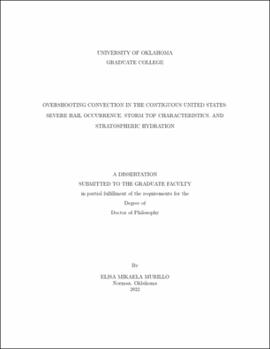| dc.description.abstract | Deep convection that overshoots the tropopause have been recognized for its relevance to stratospheric composition and prolific severe weather production for decades. Notably, tropopause-penetrating storms can inject cloud ice above the tropopause and the broader storm anvil, producing ice clouds called above-anvil cirrus plumes (AACPs). When transported into the upper troposphere and lower stratosphere (UTLS), the convectively-influenced air can modify the surrounding environment, resulting in short- and long-term impacts. Supercell storms, argued to be responsible for the majority of U.S. severe hail reports (especially for the largest sizes), also frequently produce AACPs due to the strong updrafts needed for supercell maintenance. However, U.S.\ hail report databases are plagued by serious limitations, including biases in reported sizes, occurrence time, and location, which has led to the development of various radar-based estimates of severe hail occurrence and hail size. Many established relationships between radar-observed storm characteristics and severe hail occurrence have been found using data for few storms and in isolation from other radar metrics. In addition to previous work being spatially and temporally limited, recent improvements to radar-based metrics warrant detailed comparisons between original and updated parameters.
While radar-based analyses of storm and associated severe report characteristics have a rich history, much less work has been done on these aspects of explicitly AACP-producing storms and the AACP itself. Recent studies of AACPs have shown large variability in their satellite-observed features, particularly in infrared (IR) imagery, although many of the causes remain unknown. The typical altitude range in relation to the storm anvil and tropopause height, in situ trace gas observations, and stratospheric hydration variability are all aspects of AACPs that have little-to-no existing research. The recently conducted NASA Earth Ventures Suborbital field project, Dynamics and Chemistry of the Summer Stratosphere (DCOTSS), was specifically designed to collect in situ observations and multi-satellite imagery of convectively-injected material (i.e. AACPs) in the stratosphere to better understand their effects on the chemistry, dynamics, and radiative features that are characteristic of the upper troposphere and lower stratosphere (UTLS). By leveraging the different viewing geometry between two satellites simultaneously observing one region, stereoscopy (stereo) can estimate cloud-top heights for AACPs and other cloud features. Although a few studies have utilized stereo for older generations of satellites, there lacks a focused effort to update stereo methods for next-generation satellites.
Motivated by the vast knowledge gaps in AACP understanding, associated climate impacts, existing challenges for objective severe hail identification, and recent DCOTSS observations of AACPs, the four projects detailed herein aim to better understand deep, severe convective storms on climatological timescales and their potential impacts on the climate by utilizing long data records and/or recent, novel observations. The first study aims to quantify severe hail fall characteristics during a markedly longer time period than previous studies, using both radar observations and reanalysis data, and found that an environmentally-filtered radar-based U.S.\ hail climatology provided the greatest agreement with reports. The second study evaluates the reanalysis-represented environments of radar-identified supercell populations with different maximum reported hail size, and found that the greatest differences exist in the wind speed perpendicular to storm motion. The third study compares warm and cold AACP-producing storms (based on IR signatures) using ground-based radar observations and reanalysis data to better understand the different AACP IR signatures. This study found that cold AACPs tend to occur in tropical environments (higher, cold-point tropopauses), while warm AACPs tend to occur in mid-latitude environments (lower tropopauses and an isothermal layer in the lower stratosphere). Storm-relative environmental characteristics indicate that cold AACPs are predominantly tropospheric phenomena, while warm AACPs reside in the lower stratosphere. The fourth, and final study applies a recently developed stereoscopic cloud-top height retrieval algorithm for modern GOES visible imagery to DCOTSS research flight 13 (RF13) on 31 May 2022 for comparison with in situ water vapor observations. Preliminary stereo results show moderate agreement with various observational datasets but concerning nonphysical features.
Overall, these studies provide further evidence that radar-based hail identification and size estimation can benefit from incorporating environmental information, particularly in a storm-relative framework. These studies additionally highlight the importance of understanding trace gas composition and satellite observations of AACPs to accurately characterize their impacts on the UTLS. | en_US |
